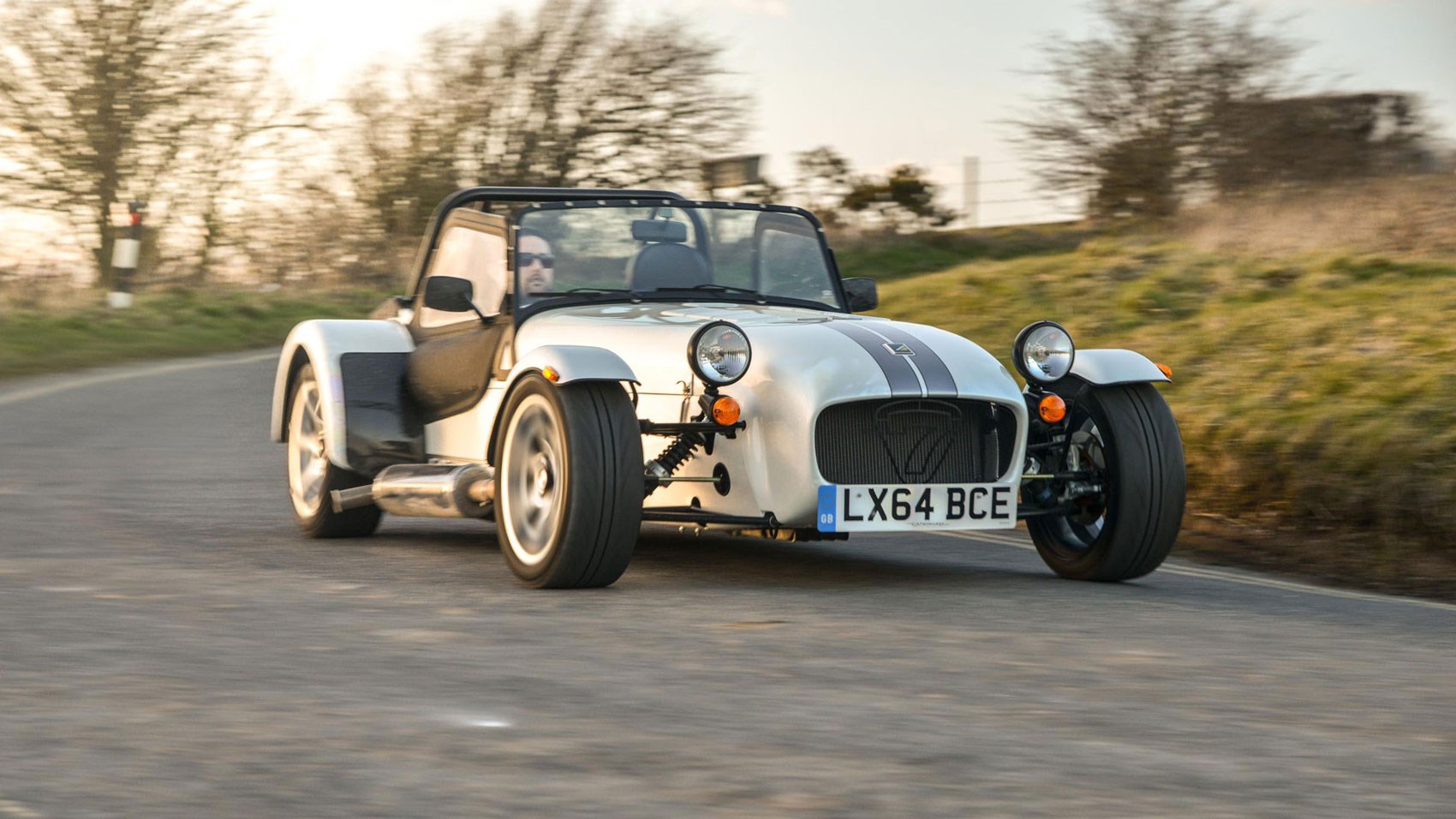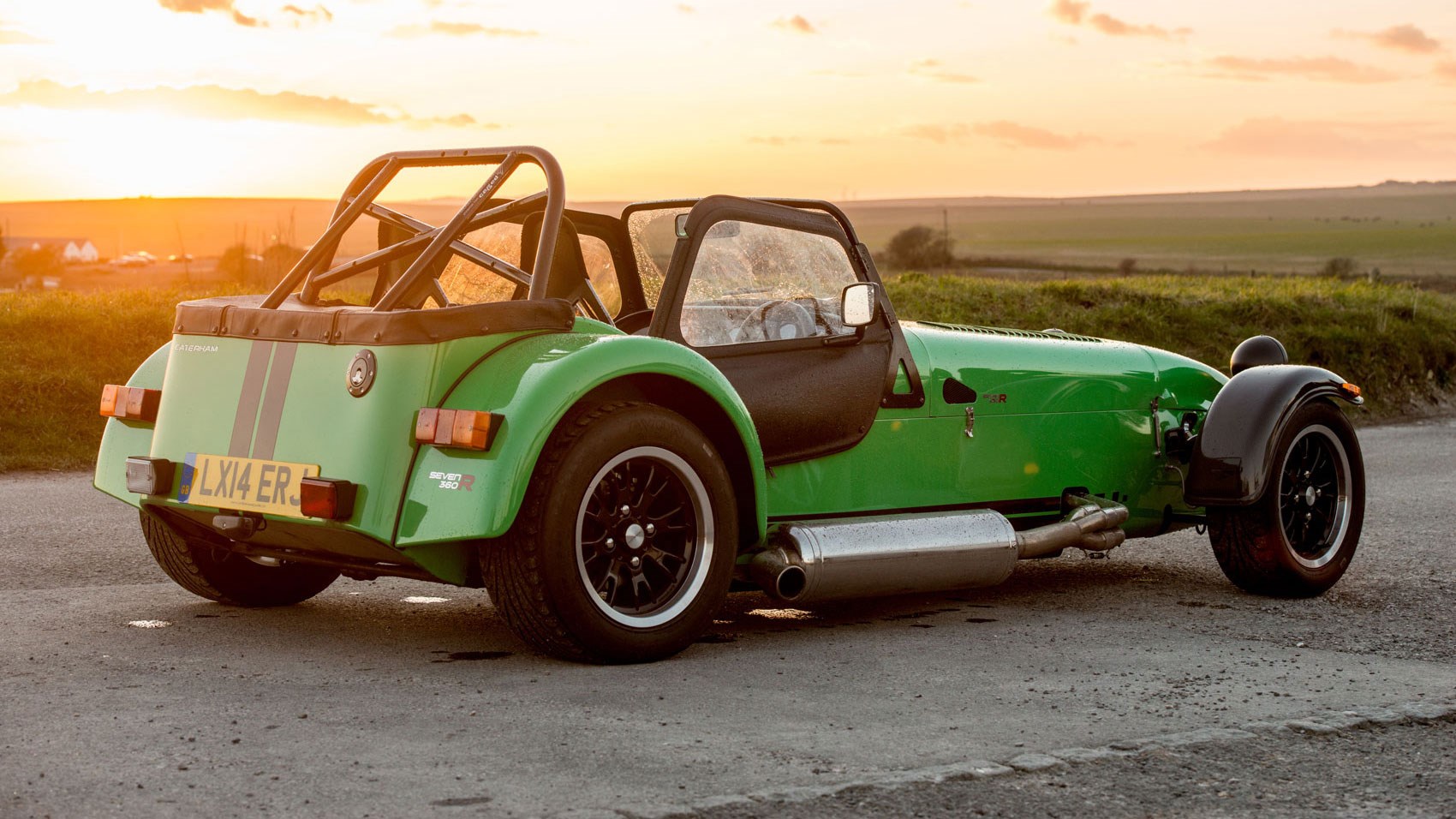► Caterham overhauls Seven line-up with new 270, 360 and 420 models
► Zingy 160 and 620 widow-maker bookend new range
► Two major packs – S and R – simplify options list
Here’s your starter for ten… What’s the difference between a Supersport, Superlight and a Roadsport? Anyone… No? Unless you lived and breathed Caterham, the badging and branding behind its range of brilliant Sevens was a black art. And its runway-long options list made things even trickier. So it’s jolly good news that the company has completely overhauled its line-up, nomenclature and options.
Here’s how it works. There are now five core models, starting with the zippy little 80bhp 160 followed by the new 270, 360 and 420 models driven here, and topped by the demonic 311bhp 620R. The model names are loosely derived from their power-to-weight ratios – the bigger the number, the more powerful the car, and the further up the price range it sits. So far, so straightforward.
This range recalibration actually started some time with the arrival of the P1-baiting 620R back in late 2013, followed by the little 160, which made its UK debut early last year, which we liked so much we took one on for 12 months as a long-termer.
Got it. Tell me about these R and S packs.
All three new models are available with the choice of two key equipment packs – the £3,995 R (racing) pack, and the £2,995 S (street) pack. Highlights of the R pack include a limited slip diff, uprated brakes and suspension, engines with lightweight flywheel, race seats, race harness and 15-inch alloys. Opt for the S and you get softer ‘road’ suspension, carpets, heater and chunky leather seats. Oh, and a windscreen, roof and doors. This is Caterham, don’t forget.
Naturally you can tweak your car further with other key options including a six-speed close-ratio gearbox, smaller and lighter 13-inch wheels, as well as the choice of the standard and snug S3 chassis or the bigger SV chassis for those whose clothes tags contain a few Xs. One final note – you can’t spec the fire-breathing 620 in laid-back S trim, and similarly, the dinky 160 can’t be ordered in hardcore R trim.
Can I still build a Seven myself?
Yes, indeed. A quick word about prices. It’s easy to get tick-box happy with a Caterham and suddenly end up with a £50,000 car, so remember this: unless you have the time, space and knowhow to do it yourself, you’ll need £3,000 to pay Caterham to build your Seven for you. And unless you’re a real masochist, you’ll need a further £1,250 for a roof, windscreen and doors. Add a further £4,000 for an S or R model and you’ll need to add £8,250 to the price of your chosen model. That said, Sevens hold onto their values with Jack Russell tenacity, so while they may initially be seen a big investment, they won’t lose their money anywhere near as quickly as most fast exotica.
We went up to Caterham’s shiny new Crawley showroom in West Sussex and spent the day driving two versions of the 270 – one in S and one in R trim, and then the 360R and 420R. And we liked them a lot.
Caterham Seven 270S

We head out first in the 270 in SV guise and kitted out with the optional S pack. It’s powered by a 1,596cc Ford Sigma four-pot with trick variable valve timing that dishes up 135bhp at 6,800rpm and 100lb ft at 4,100rpm – enough to rocket the 540kg Seven to 60mph in five seconds dead and on to 122mph. If your motoring diet up to this point consisted of humdrum hatches and family carry-alls, then the 270S will leave you grinning like a loon. It’s quicker and nimbler than a troupe of River Dancers, peeling into corners and scything through bends with pin-sharp accuracy and real verve.
But if you’ve driven a Caterham before, any recent Caterham, then the 270S will feel, well, surprisingly soft. The compliant ride, the spacious SV cabin (relatively speaking, that is), and the big 15-inch alloys shod with chunky 195/45 R15 rubber all temper the Seven’s engagement levels and blur its dynamics. Perfect for those drivers wanting something with more bite than the 160 when out on sunny summer weekend runs.
Caterham Seven 270R
Yes, now we’re talking. Despite sharing the identical drivetrain, the R feels just the way a Caterham should – whip-crack quick and keyed into the road with every touch- point hardwired in to your brain. Telepathic steering, Scalextric-trigger throttle control, immaculate body control, rocket-sled pace – all the Caterham hallmarks are there to transform any drive into a scintillating blast.
That’s what you get when you tick the R option, an immersive driving experience further enhanced by the slimline S3 body, smaller 13-inch alloys and six-speed ’box fitted to our test car. There’s nothing at this price that comes close to matching it on a smile-per-mile basis. It’s the Caterham we all want on our driveway, no matter what the weather or the destination. Well, that’s what we thought until we drove the 360R.
Caterham Seven 360R

The 360R feels like driving the 270R on fast forward. Its tuned 1,999cc Ford Duractec may be peakier with its 143lb ft only arriving at a high 6,100rpm but with 180bhp dished up at a howling 7,300rpm, the 360R feels viciously quick. In the 270R you can work your way quite quickly up to its limits, using the throttle as much as the doughnut-sized Motolita steering wheel to change direction. The 360R has a much steelier glint in its eye. It’s a serious driving tool, and larking about in it will very quickly end up in an expensive and painful interface with the scenery. The occasional wheelspin at 80mph in the dry or unexpected palm-dampening corner wiggle is its way of keeping you on your toes. With its extra dose of intimidation, it’s a far more challenging, and ultimately more rewarding drive.
Caterham Seven 420R

If the 360R leaves you a bit wide-eyed and dry-mouthed, then the 420R will feel utterly unhinged. Like the 620R above it, the 420R is best judged as murderous track weapon rather than road racer. It may only pack 30bhp and 7 lb ft more than the 360R, but borrowing the 620R’s suspension, brakes and super-sticky tyres makes it feel so much more intense and focused than its (slightly) lower-powered counterpart. It’s savagely visceral, demanding complete and utter concentration and commitment. At anything below dear-God-I’m-going-to-die speeds if feels truculent and sulky, goading you to push harder, to swallow your fear, not think about your children or when you last updated your will and trust it to do what doesn’t seem physically possible. Because it can go round corners and reel in straights at a rate your brain will always have difficulty comprehending. It’s one hell of a weapon.
So which do I buy?
Well, don’t discount the 160 simply because of its position on the bottom rung of the Seven ladder. It’s a brilliant little package that puts the emphasis on driver engagement rather than outright pace. If you want to amp things up a touch, the 270R is perhaps the perfectly balanced model in the range. But if you’ve got a pair of brave pants, and you wear them well, then the 360 should definitely be on your radar.
The 420R is all a bit too much for the road, and probably best suited to seriously wedged-up trackday warriors. And if you want to frighten the bejaysus out of yourself, your bank manager and every other road and track user, then look no further than the 620R. Point to point, nothing this side of a Bugatti is quicker.
A successful shake-up for Caterham, then?
I’d say. These new models, revised nomenclature and a rationalised options list now make Caterham far more accessible. It may be an anachronistic minnow in todays’ hyper-tech automotive ocean – who else produces cars without any safety gear, and has doors as pay-for options? – but its cars still deliver a pure and immersive driving experience that, at the price, no other carmaker comes anywhere close to matching. If you’ve never driven a Caterham, use these new models as an excuse to change that. You’ll never feel the same way about driving again.